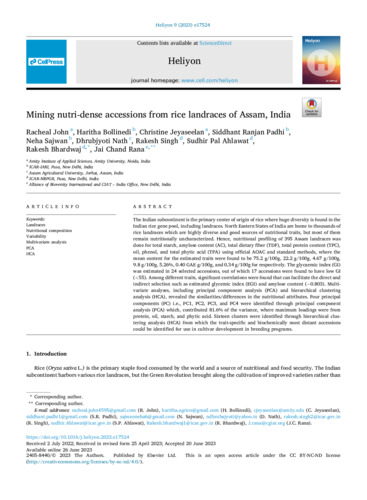Mining nutri-dense accessions from rice landraces of Assam, India
The Indian subcontinent is the primary center of origin of rice where huge diversity is found in the Indian rice gene pool, including landraces. North Eastern States of India are home to thousands of rice landraces which are highly diverse and good sources of nutritional traits, but most of them remain nutritionally uncharacterized. Hence, nutritional profiling of 395 Assam landraces was done for total starch, amylose content (AC), total dietary fiber (TDF), total protein content (TPC), oil, phenol, and total phytic acid (TPA) using official AOAC and standard methods, where the mean content for the estimated traits were found to be 75.2 g/100g, 22.2 g/100g, 4.67 g/100g, 9.8 g/100g, 5.26%, 0.40 GAE g/100g, and 0.34 g/100g for respectively. The glycaemic index (GI) was estimated in 24 selected accessions, out of which 17 accessions were found to have low GI (<55). Among different traits, significant correlations were found that can facilitate the direct and indirect selection such as estimated glycemic index (EGI) and amylose content (-0.803). Multivariate analyses, including principal component analysis (PCA) and hierarchical clustering analysis (HCA), revealed the similarities/differences in the nutritional attributes. Four principal components (PC) i.e., PC1, PC2, PC3, and PC4 were identified through principal component analysis (PCA) which, contributed 81.6% of the variance, where maximum loadings were from protein, oil, starch, and phytic acid. Sixteen clusters were identified through hierarchical clustering analysis (HCA) from which the trait-specific and biochemically most distant accessions could be identified for use in cultivar development in breeding programs.

